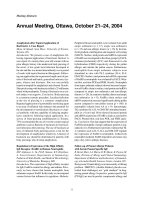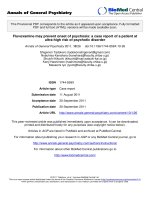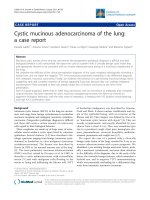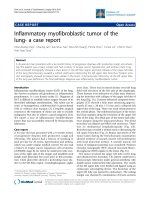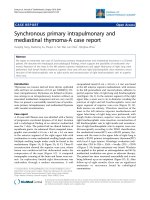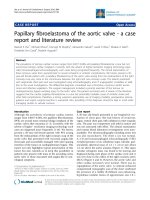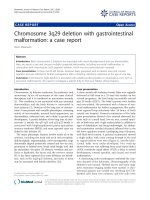Báo cáo y học: " Fatal pulmonary embolism following shoulder arthroplasty: a case report" potx
Bạn đang xem bản rút gọn của tài liệu. Xem và tải ngay bản đầy đủ của tài liệu tại đây (167.76 KB, 3 trang )
Case report
Open Access
Fatal pulmonary embolism following shoulder arthroplasty:
a case report
Thayur R Madhusudhan
1
*, Sanath K Shetty
1
, Savitha Madhusudhan
2
and Amit Sinha
1
Addresses:
1
Department of Trauma and Orthopaedics, Glan Clwyd hospital, Rhyl, LL18 5UJ, UK
2
Department of Ophthalmology, H M Stanley Hospital, St. Asaph, LL170RS, UK
Email: TRM* - ; SKS - ; SM - ; AS -
* Corresponding author
Received: 1 January 2009 Accepted: 29 May 2009 Published: 31 July 2009
Journal of Medical Case Reports 2009, 3:8708 doi: 10.4076/1752-1947-3-8708
This article is available from: />© 2009 Madhusudhan et al.; licensee Cases Network Ltd.
This is an Open Access article distributed under the terms of the Creative Commons Attribution License (
/>which permits unrestricted use, distribution, and reproduction in any medium, provided the original work is properly cited.
Abstract
Introduction: Fatal pulmonary embolism following a shoulder joint replacement is a rare event. The
exact prevalence of shoulder arthroplasties is not clear. Unlike hip and knee joint replacements
where some form of thromboprophylaxis is routinely prescribed, no such guidelines and practice
exist for shoulder replacements. Other case reports have confirmed fatal and non-fatal pulmonary
embolisms following shoulder replacements, but particular risk factors were identifiable in those
patients.
Case presentation: We report the case of a 73-year-old Caucasian woman with fatal pulmonary
embolism secondary to a calf deep vein thrombosis following a shoulder joint replacement
procedure. The patient was otherwise healthy; there were no other risk factors directly contributing
to deep vein thrombosis and pulmonary embolism except for a body mass index of 34. Post-mortem
examination confirmed that the patient had a thrombus in the calf and a pulmonary embolus.
Conclusions: Fatal deep vein thrombosis and pulmonary embolism can occur following shoulder
joint replacements in otherwise normal patients. A high degree of suspicion should therefore be
maintained in susceptible individuals. Thromboprophylaxis needs careful consideration in shoulder
replacements in susceptible individuals.
Introduction
Deep vein thrombosis and pulmonary embolism
(DVT/PE) are recognized complications of hip and knee
joint replacements. Because definite guidelines in addres-
sing these conditions are already in place, some form of
thromboprophylaxis is routinely prescribed to high risk
patients. DVT/PE occurrences, however, are uncommon in
shoulder arthroplasties and there are no guidelines
currently in place. Case reports and other recent studies
do suggest, however, that these events are no longer as rare
as suggested in the literature. The physician needs to
consider these events in shoulder replacements.
Page 1 of 3
(page number not for citation purpos es)
Case presentation
A 73-year-old Caucasian woman was admitted for elective
shoulder replacement for an arthritic shoulder. She was
being treated for hypertension with beta-blockers and
thiazide diuretics and her blood pressure was well
controlled. She had a history of diverticulitis and varicose
vein surgery with an uneventful outcome. Her body mass
index (BMI) was 34 during pre-operative anesthetic
evaluation. She had no family history of DVT/PE. Blood
investigations including electrolytes, liver function tests
and coagulation screening were normal. Results of her
electrocardiogram (ECG) and chest X-ray were unremark-
able. The comorbidities were well optimized and she was
admitted a day before her operation.
The patient w as operated under general anes thesia
supplemented with an interscalene block for postoperative
analgesia. An intermittent calf compression device was
used for mechanical thromboprophylaxis intraoperatively.
The operation was performed through an anterior
deltopectoral approach. The patient had no intraoperative
complications. The patient recovered satisfactorily from
general anesthesia and was monitored in a high depen-
dency care unit for postoperative optimization. The
operated shoulder was supported in an arm sling support
for comfort. The patient was prescribed postoperative
opioid analgesics and antibiotic prophylaxis with three
doses of cefuroxime. No chemical or mechanical thrombo-
prophylaxis were used postoperatively.
The patient was already feeling well on the next post-
operative day and her blood parameters were satisfactory.
Her pain was well controlled and her arm continued to be
immobilized by the sling. There was no excessive oozing
from the surgical wound and there were no distal
neurovascular deficits. The patient’s calves were soft and
nontender and she was ambulating well postoperatively.
A systemic examination of the patient was unremarkable.
However, while being monitored she suddenly became
breathless, hypoxic and hypotensive and exper ienced
intense sweating. She did not complain of chest pain
and an ECG was negative for cardiac ischemic changes. Her
PaO
2
was 84% on room air. She was resuscitated with
oxygen by mask and initiated on low molecular weight
heparin in a therapeutic dose. Despite all resuscitative
measures the patient could not be revived. A post-mortem
examination was requested, which confirmed pulmonary
embolism and left calf deep vein thrombosis.
Discussion
Deep vein thrombosis and pulmonary embolism are
recognized complications of hip and knee joint replace-
ments and pelvic operations. Definite guidelines for
prevention and treatment exist [1] in knee and hip
arthroplasties. Earlier studies reported that the occurrence
of pulmonary embolism is a rare event following shoulder
arthroplasty [2,3] and that a high degree of suspicion
is warranted should the patient develop r espi ratory
difficulty following a shoulder arthroplasty. There were
no reported fatal events related to such conditions.
However, recent studies [4,5] have indicated that
although the absolute rates of thromboembolic compli-
cations were lower in patients who h ad shoulder
arthroplasties compare d with those who had lower
limb procedures, a larger percentage of these complica-
tions were pulmonary embolisms. Perioperative antith-
rombotic prophylaxis may be beneficial to reduce the
frequency of deep venous thrombosis and pulmonary
embolism among patients undergoing shoulder arthro-
plasties, particularly in higher-risk groups. A relatively
high incidence of deep vein thrombosis after shoul der
arthroplasty has also been reported. Still, more studies
are required for definite conclusions and for establishing
guidelines for t hromboprophylaxis.
Saleem et al. report that the origin of thrombus in their
reported patient was secondary to a deep vein leg
thrombosis and this was attributed to a period of prolonged
immobilization in the perioperative period [6]. In our
patient, there were no identified risk factors for DVT or PE
during pre-anesthetic evaluation. Clinical examination in
the postoperative period was normal, and the patient was
ambulating well with no signs of deep vein thrombosis in
her calf. Due to a lack of clinical evidence and an absence of
definite risk factors, no chemical and mechanical throm-
boprophylaxis was considered postoperatively. An
intermittent mechanical compression device used
intraoperatively may not prove beneficial in this setting.
For the same reason, we were also unable to correlate the
association between deep vein thrombosis of the legs and
shoulder arthroplasty in our patient. Further exploration
may point to other less known risk factors that could have
contributed to the process of venous thrombosis and the
subsequent pulmonary embolism.
Conclusions
Deep vein thrombosis and pulmonary embolism can
occur and prove fatal following shoulder arthroplasty.
Thromboprophylaxis needs careful consideration in the
selection and management of patients.
Abbreviations
BMI, body mass index; DVT, deep vein thrombosis; ECG,
electrocardiogram; PaO
2
, Partial Pressure of Oxygen in
Arterial Blood; PE, pulmonary embolism.
Consent
Written informed consent was obtained from the next of
kin of the patient for publication of this case report. A copy
Page 2 of 3
(page number not for citation purpos es)
Journal of Medical Case Reports 2009, 3:8708 />of the written consent is available for review by the Editor-
in-Chief of this journal.
Competing interests
The authors declare that they have no competing interests.
Authors’ contributions
TRM was the principal author and was involved in the
collection of data, review of literature, and preparation of
the manuscript. SKS and SM were involved in the
collection of literature and in editing the manuscript.
AS was the senior author and was actively involved in
patient care and in editing the manuscript. All authors
read and approved the manuscript.
References
1. National Institute for Health and Clinical Excellence. [www.
nice.org.uk/CG046fullguideline].
2. Sperling JW, Cofield RH: Pulmonary embolism following
shoulder arthroplasty. J Bone Joint Surg Am 2002, 84-A:1939-1941.
3. Rockwood CA Jr, Wirth MA, Blair S: Warning: Pulmonary
embolism can occur after elective shoulder surgery: report
of two cases and survey of the members of the American
Shoulder and Elbow Surgeons. J Shoulder Elbow Surg 2003,
12:628-630.
4. Lyman S, Sherman S, Carter TI, Bach PB, Mandl LA, Marx RG:
Pre vale nce and risk fact ors for symptomatic thro mbo-
embolic events after shoulder arthroplasty. Clin Orthop Relat
Res 2006, 448:152-156.
5. Willis AA: Deep vein thrombosis after reconstructive shoulder
arthroplasty: a prospective observational study. J Shoulder
Elbow Surg 2009, 18:100-106.
6. Saleem A, Markel DC: Fatal pulmonary embolus after shoulder
arthroplasty. J Arthroplasty 2001, 16:400-403.
Do you have a case to share?
Submit your case report today
• Rapid peer review
• Fast publication
• PubMed indexing
• Inclusion in Cases Database
Any patient, any case, can teach us
something
www.casesnetwork.com
Page 3 of 3
(page number not for citation purpos es)
Journal of Medical Case Reports 2009, 3:8708 />
